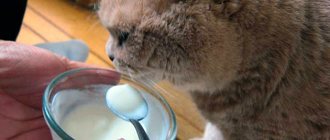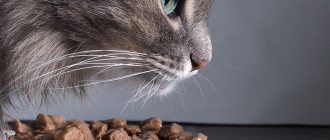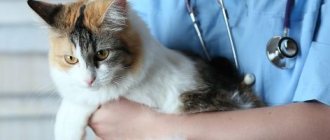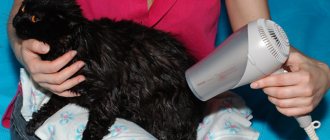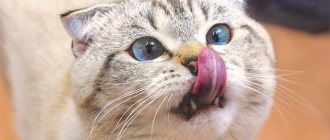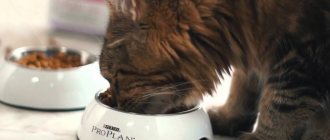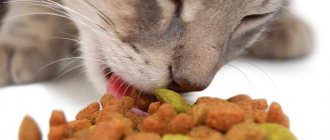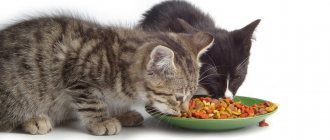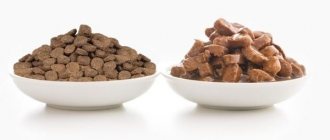Unbalanced diet
Dry food is a complete diet that has been specially developed to become the main and only source of nutrients for animals. It is balanced in proteins, fats, carbohydrates, vitamins and minerals, and does not require any supplements other than clean drinking water. If we give our pet both dry food and canned food, the balance of substances becomes questionable.
Please note that ready-made food for cats in jars and bags is not always complete: in some cases, these are just treats that cannot be the basis of the daily menu. Even if you select canned food labeled “complete,” it is not a fact that this will improve the animal’s nutrition.
It makes sense to supplement dry food with a high meat content only with products of similar quality. The trouble is that sometimes canned food looks like meat only in appearance, but in fact turns out to be half made of vegetable protein sources in the form of grains. For cats that are obligate (that is, strict) carnivores, such a menu is absolutely not suitable: over time, it can lead to illness, weakened immunity, and deterioration of the skin and coat.
In high-quality canned food, meat ingredients should predominate, but there should be no grains at all: while the presence of sources of carbohydrates in dry food (and even much better alternatives) is partly justified by the peculiarities of the technology, then here they are absolutely not needed.
Firstly, not all cats tolerate an abundance of grains well. Secondly, excess carbohydrates cause sharp spikes in blood sugar and place increased stress on the pancreas. Thirdly, a high-carbohydrate diet changes the pH balance of urine to the alkaline side, and this is one of the factors in the development of KSD.
Also, canned food should not contain:
- dyes and flavors;
- sugar in any form;
- ingredients under common names.
If the list of ingredients says “meat products” or “by-products”, but does not even indicate what source they were obtained from, this does not inspire confidence. Most likely, different batches use different raw materials, and of questionable quality. And although industry regulations do not prohibit naming ingredients by groups, this should at least cause caution for a responsible owner.
Is it possible to feed a cat canned fish?
Is it possible to feed a cat canned fish ? Some cat owners may say that they feed their cat canned food all his life, and nothing. Maybe nothing for now, but this diet clearly backfired on our cat.
Our Kesha is generally a gourmet, and will not eat just anything. Most of all he loves sprat in tomato and sour cream. He may even dance for these treats. Out of false pity, we tried to give Kesha his favorite sprat more often. If we knew how it would end, we would never have done this.
One fine day, Kesha refused to eat. That was incredible. At first we thought he was just overeating because the day before we had fed all our cats a ton of scraps of meat. But no one refused to eat after that.
On the second day, Kesha even stopped drinking. This already alarmed us, but it was reassuring that there was no blood in his urine.
On the third day I took him to the vet. They examined and touched him for a long time, but nothing dangerous was found. Just in case, he was injected with vitamins and sent home.
Two days later, we began to inject glucose and saline into his withers to prevent dehydration. We went to the system for another week. Veterinarians diagnosed him with urolithiasis. But I didn’t believe it, because... With this disease, cats cannot urinate, and Kesha blew at least half a liter several times a day.
After a couple of days, he suddenly turned all orange, although he already had a red color. It became clear even to me that his illness was related to the liver. We didn't stop stabbing him. What was prescribed was what they injected. But a week later, the veterinarians said that his liver had already completely decomposed, and there was no point in further treatment.
And then my mother ended up in the hospital with a broken arm, and my daughter and I decided not to torture the cat and let him die peacefully. Kesha no longer had the strength, but he still went to the toilet. We didn't do anything with it for a week and a half. Only in the morning and evening I wiped Kesha with a wet cloth and tried to at least give her something to drink. But it was all in vain. The cat slowly faded away.
Every morning I approached him with fear and stroked his head. There was only one skin left from the cat. The smell emanated from him was such that flies flocked to him. But the cat didn’t want to die.
The dog developed otitis (ear disease), and I called the veterinarian to the house. She was very surprised that the cat was still alive and suggested that he be euthanized. I flatly refused.
A couple of days later, my mother was discharged from the hospital, and when she saw that Kesha was still alive, she told me to immediately take time off from work, go to the pharmacy, buy new solutions of glucose and saline, and run home. I did so, although I understood that nothing would help Kesha. He had been without water for too long.
And yet I wanted to believe in a miracle. My mother couldn’t help me hold the cat, so I asked my daughter. Oddly enough, he still had strength. I was very nervous. I felt sorry for the cat. The skin on the withers has become hard. I could barely pierce it. Somehow we were able to inject him with a couple of 20 gram syringes of solutions.
And suddenly the cat screamed in a wild voice, jumped up, ran, staggering several meters, fell and froze with glassy eyes. All three of us stood over him and roared in one voice. It was clear that he was killed.
And a few minutes later it dawned on me that I had incorrectly calculated the dose of medication and infused it twice as much as normal. The cat was not breathing, and we went into another room to decide what to do next.
And suddenly, in the ringing silence (even our other cats and dog fell silent and did not show themselves) we heard the sounds of lapping water. I carefully went into the kitchen and almost fell in surprise.
Kesha stood over a jar of water and quickly lapped up the water. It was something incredible. He drank almost half a liter. Then he turned around and staggered towards the food bowl. I barely managed to hide it. After such a hunger strike, food can only be given in crumbs, otherwise the cat will die.
For two days we fed Kesha hourly and little by little. He screamed and kept asking for food. We could barely hold back our tears, but we stuck to the diet. From lying for a long time, open wounds-bedsores formed on his paws. I had to treat them with levomekol.
A week later, Kesha became normal in color and was slowly gaining weight. A week later, I took the cat to the veterinarians for examination. They couldn't believe he survived. They even thought that I had found the same cat and brought it to them.
We no longer give him sprat in tomato, and we don’t buy canned food at all. It’s good that we only fed him with these canned foods, otherwise all our cats could have gotten sick, and even then such healing would not have happened, because Kesha is the strongest cat we have. And he had a real non-infectious hepatitis. Apparently the tomato sauce with spices disrupted the liver.
This is how we realized that such food for cats is very dangerous. And now, no matter how much we want to pamper our pets, we have to think about the consequences. Now we know how many times a day and what to feed the cat, and whether it is possible to give it dog food.
Take care of your pets!
Overfeeding your pet
When combining dry food and canned food in your cat's diet, it is important to ensure that she does not overeat. Obesity in pets is not uncommon with mixed and disorderly feeding. It is important to find out the daily intake of dry food (information about this is presented on the packaging) and cut it down exactly as much as the cat receives canned food.
For example, the daily dosage of Acana Grasslands food for a cat weighing 4 kg is 60 grams, or 243 kcal. In the evening, the animal also receives 100 grams of pate, the calorie content of which is 87 kcal. Let's do the math:
- 243 – 87 = 156 kcal – reduced dosage of dry food;
- 243: 60 = 4.05 kcal - in one gram of feed;
- 156: 4.05 ≈ 39 grams - this is how much dry food a cat should receive, taking into account the fact that he also eats canned food.
What to feed cats at home inexpensively?
The main component in an animal's diet should be pure meat. It can be chicken, turkey, rabbit, or beef. To feed cats at home inexpensively, you can use offal - hearts, stomachs, lungs, liver (with caution). It is permissible to add meat and bone components, but only in ground form (chicken necks, legs, joint parts).
Among vegetables, carrots, zucchini, cauliflower, pumpkin, potatoes or sweet potatoes are added to the diet.
Add a little vegetable oil (olive or sunflower) to the finished food. It is more useful to do this immediately before feeding. A couple of drops per serving will be enough.
In order to save time, when eating at home, ready-made rations can be prepared for future use and stored in canned or frozen form. When freezing, it is more convenient to divide the food into the required portions.
Eating problems
Cats fed dry food and canned food sometimes become picky eaters, which makes life very difficult for the owner. The fact is that food saturated with moisture is always more aromatic and attractive than dry granules. As a result, the cat ignores the full bowl of food, but follows the owner on his heels, begging for his favorite treat.
If this is not part of your plans, it is better not to offer your pet canned food: dry food is enough for him. Animals do not at all need variety in the human understanding: they can eat the same thing for years without suffering from it.
What kind of canned food attracts cats?
To arouse the interest of pets, canned food must have a pronounced fish or meat aroma . These aromas that cats prefer in food will be felt brighter in canned food, since in addition to natural ingredients, manufacturers can add artificial additives and flavor enhancers.
Cats have a very keen sense of smell, so it is not difficult for them to determine the freshness of food from afar. The animal will not approach stale canned food.
Individual reactions
Any industrial feed is a multi-component product. And sometimes it happens that one of the components causes an individual undesirable reaction in a cat (food intolerance, allergy). When you use both dry food and canned food, it will be doubly difficult to understand the reasons for this phenomenon.
If your pet is prone to allergies or has sensitive digestion, it is better not to experiment with its diet again.
For those who still decide to feed their cat dry food and canned food at the same time, it is important to adhere to the following rules:
- do not introduce two new foods one after the other and do not mix them in one bowl, the normal adaptation time to a new food is 7-10 days;
- Do not use products where protein sources are named in general terms, because it may turn out that some “meat products” include chicken, to which your cat is allergic.
To give or not to give?
there is no direct need to feed them to domestic cats .
In addition, for cats with a very sensitive digestive system, eating canned food can lead to disruption of the body's excretory functions. But if the animal is healthy and has a great desire to eat canned food, you can give it to the animal in small quantities, but not on a regular basis . Anyone, even the healthiest animal, can begin to fail if the cat is fed canned food constantly, in large quantities.
If the cat is completely healthy, you can add a small amount of canned meat or fish to its usual natural diet, you can significantly please the animal, which will lead to a decrease in aggression and anxiety.
How to give canned food correctly?
Naturally, the dose of treats given should be small. Canned food can be given to healthy cats whose diet consists of natural products: porridge, soups, meat, fish, eggs.
You should not combine regular canned food with cat food to avoid intestinal dysfunction. If an animal consumes exclusively specialized food, a sudden change in its diet by introducing unfamiliar products will have a detrimental effect on its body.
Since ordinary canned food may contain substances that irritate the delicate lining of the intestines, they should be given mixed with other foods, thus, the negative effects after eating them can be somewhat reduced.
It is very important to remember that a mono-diet of canned food alone can harm even the healthiest animal.
It is preferable to feed canned food containing lean varieties of fish or meat - such a product will be easier for the cat to digest. Canned saury or pork can have a negative effect on the liver, because this organ of cats is very sensitive to large amounts of fat.
Canned food should not be given together with fermented milk products, such as fermented baked milk or cottage cheese, as the protein contained in them will conflict with fermented milk bacteria.
